Part 43: Philippine Sea: July 20, 1944 (afternoon)

We've gained some amount of revenge for Pearl Harbor by sinking the Yamato, and we're hoping to bag several carriers and another few battleships as well.
Allied Turn 10 (USA): July 20, 1944
Fair, Dry

The Northampton engages the Mushashi, but the damaged battleship once again knocks back our ships, and a shot to the Northampton's bridge forces the attack to break off.
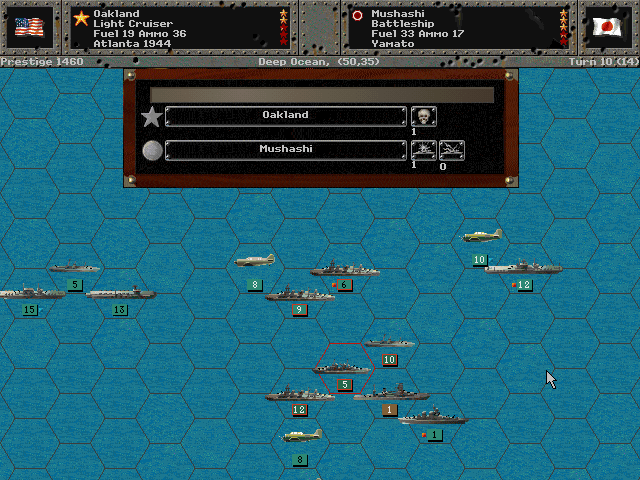
More ships join the attack, and the Mushashi is on its last legs. Even the Iowa fires from long range, but the big ship is still afloat.
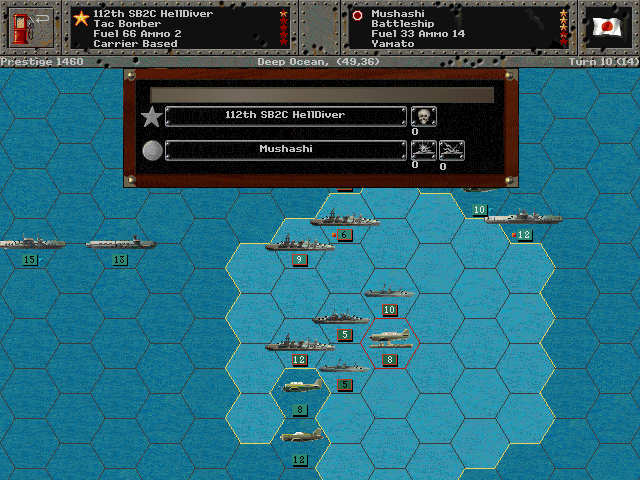
Even two air strikes fail to sink it.
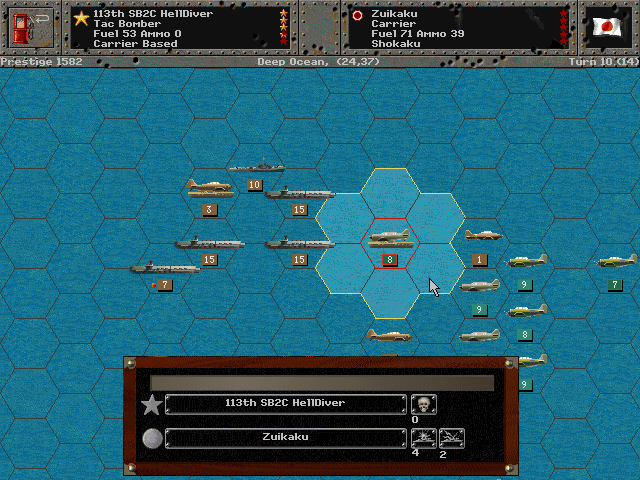
Strikes on the carriers are faring much better. The Zuikaku and Shokaku, and Junyo all take heavy bomb hits.
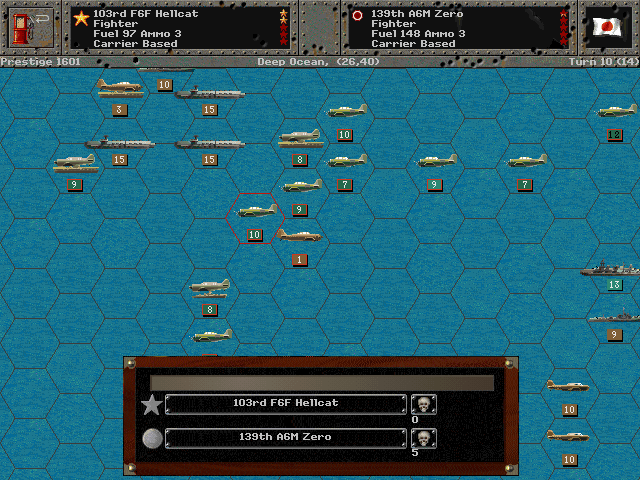
Even more of the enemy aircraft are shot down, too.
Axis Turn 10 (Japan): July 20, 1944
Fair, Dry
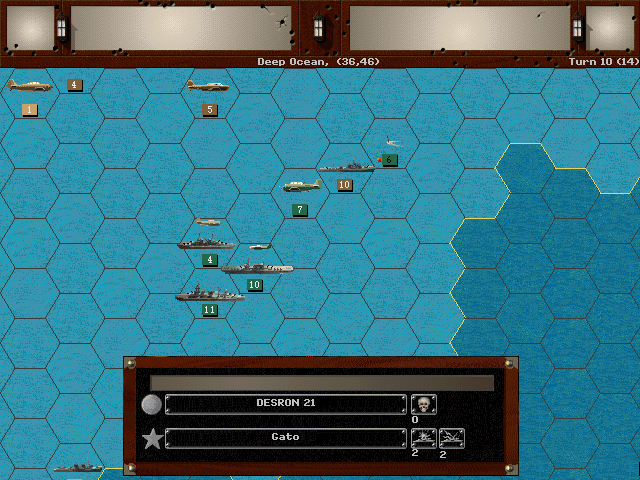
Our sub is having a difficult time evading the Japanese destroyers.

Some other small ships engage the Enterprise, but no serious damage results.
Allied Turn 11 (USA): July 20, 1944
Fair, Dry
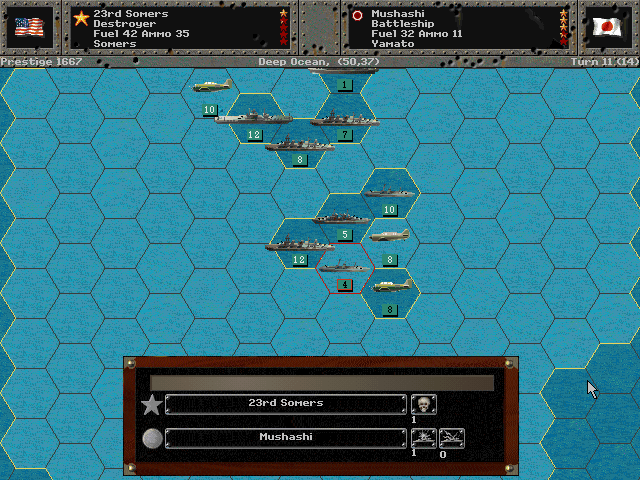
In the end, the heavily damaged Somers is the ship that delivers the killing blow to the Musashi.

The planes from the northeastern group finally have reached the attack area. The Taiho is nearly sunk.
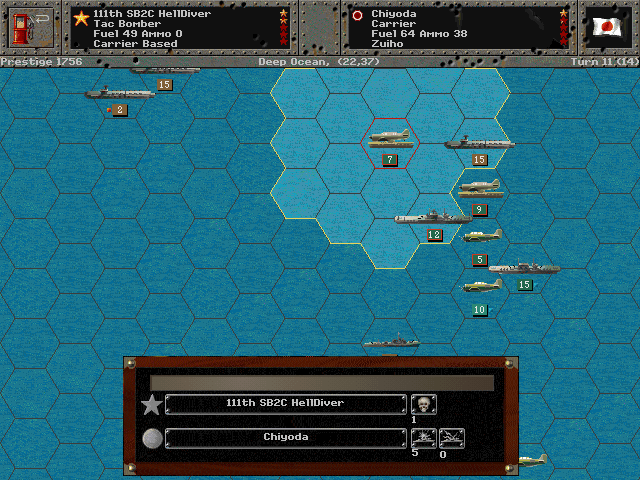
We're also ripping through the smaller carriers.
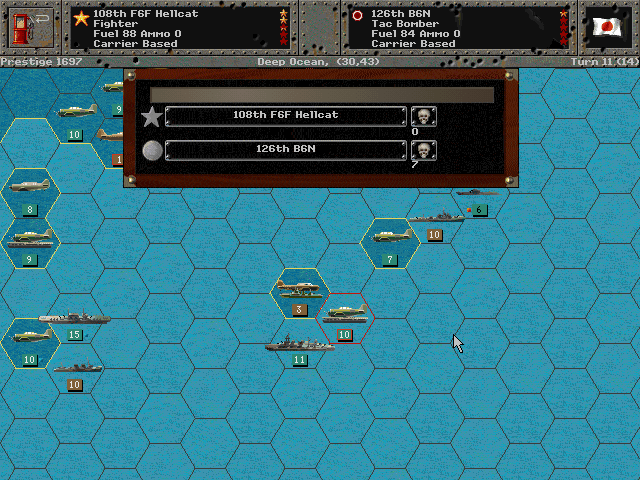
With almost all the escorts gone, the Japanese planes are easy pickings.
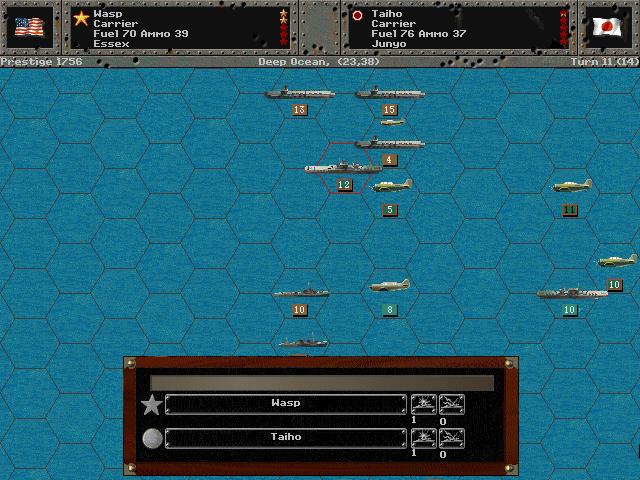
An unusual occurrence in the battle: Carriers firing on each other with guns.
Axis Turn 11 (Japan): July 20, 1944
Fair, Dry
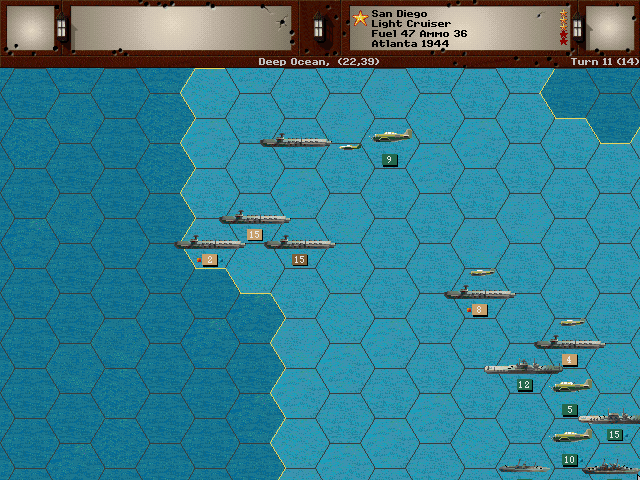
The enemy fleet is in full withdrawal now.
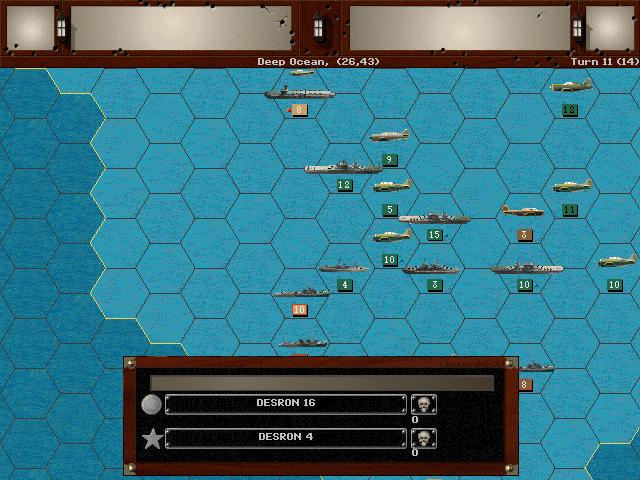
Only the destroyers hang around to screen the retreat.
Allied Turn 12 (USA): July 20, 1944
Fair, Dry
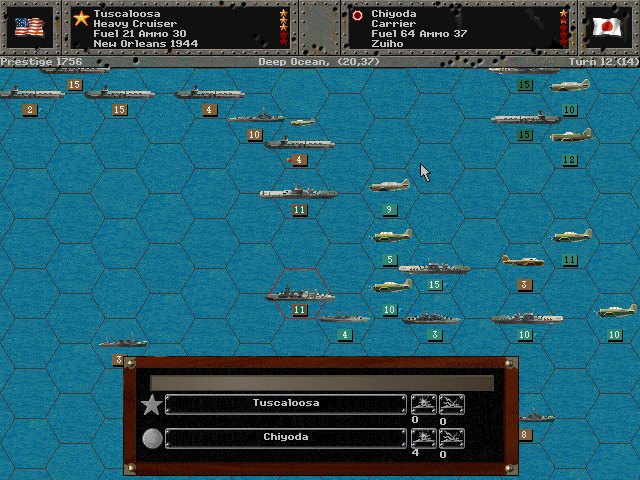
American surface ships have caught up with the enemy, and we're sinking them the old-fashioned way.
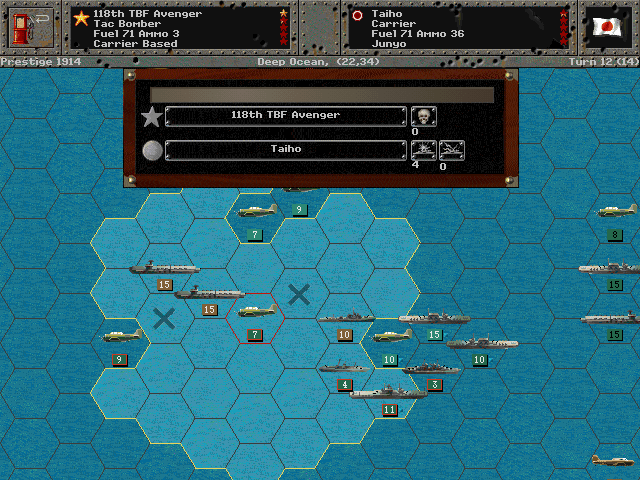
Two big carriers (Junyo and Taiho) succumb to air attack.
Axis Turn 12 (Japan): July 20, 1944
Fair, Dry
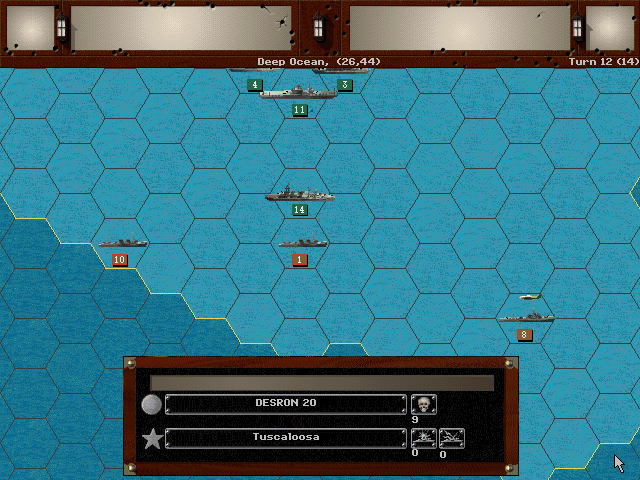
The destroyers try to stop us, but they are merely a minor distraction to our more powerful cruisers.
Allied Turn 13 (USA): July 20, 1944
Fair, Dry

The Ryuho, on fire from an earlier attack, takes a torpedo hit and sinks.
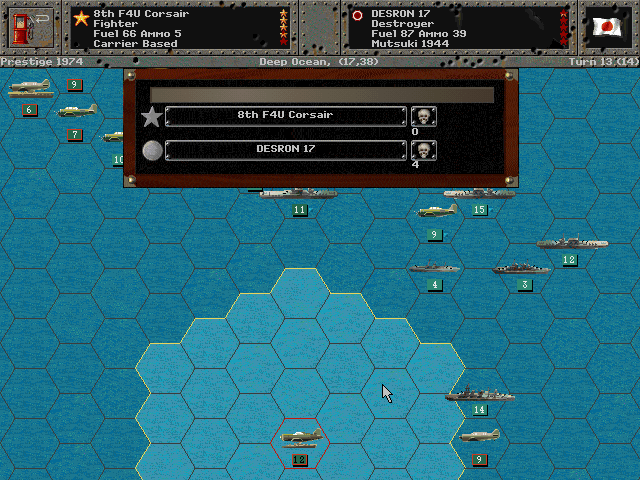
With the enemy aircraft either shot down or being held in hangars, our fighters go after the destroyers.
Axis Turn 13 (Japan): July 20, 1944
Fair, Dry
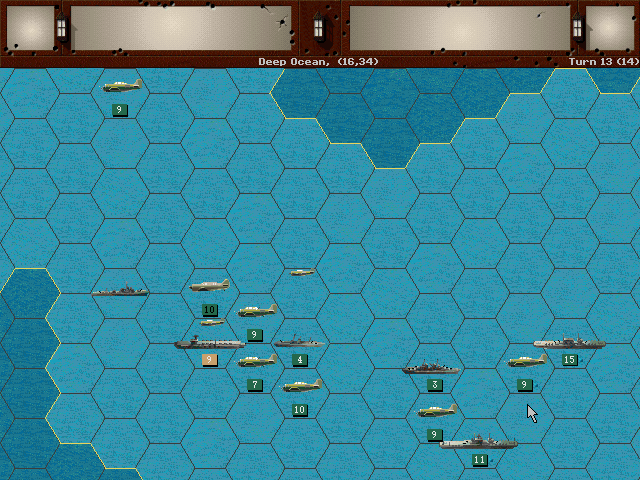
Knowing the end is inevitable, the last few ships just pull away slowly.
Allied Turn 14 (USA): July 20, 1944
Fair, Dry

Knowing we have the battle in hand, even the Gato surfaces in view of the enemy destroyers. They don't expect to sink any of them, but they do help guide a flight of Helldivers in to the target.
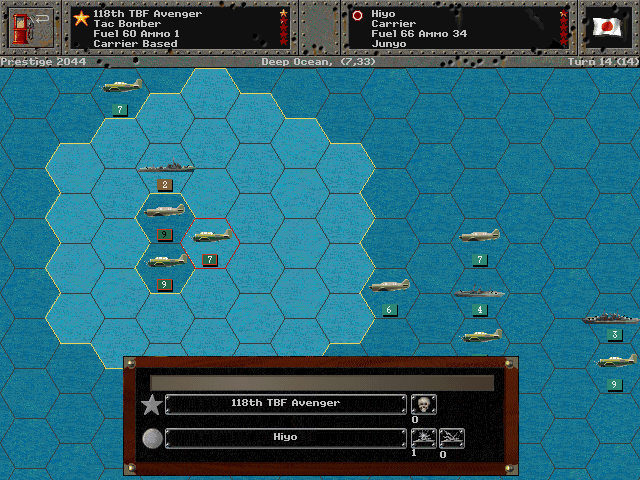
After several more strikes the Hiyo is sent to the bottom too.

Only the Zuikaku manages to survive the fight.
Axis Turn 14 (Japan): July 20, 1944
Fair, Dry
It has been a crushing defeat for the Japanese. Their attempt at a decisive naval battle ended in complete failure.
Result: Marginal Victory (1548-1038)
It also turned into a tough battle for our core, and we lost some good units. It could have been much worse, but it could also have gone better too.
Ending Prestige: 2804
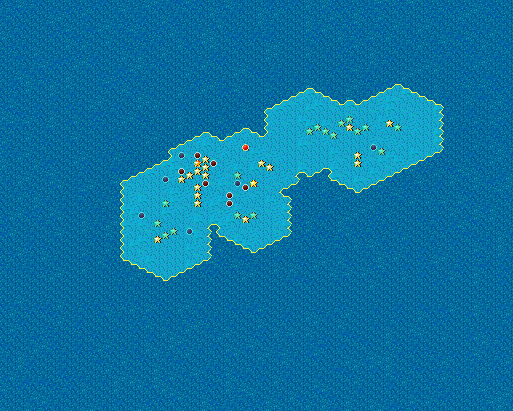
Unit Spotlight
M10 GMC 'Wolverine' (video link)
PG Name: M10 Wolverine Type: Anti-Tank
Effective Date: 1/44
Value:10 Cost:120 Spot:1 Move:6 MM:Track Trans:Naval Fuel: 57
Init:10 SA:9 HA:15 AA:[2] NA:0 GD:10 AD:8 CD:2 TT:Hard Ammo:7
The Americans produced the M4 medium tank in such quantity that using the chassis for just about anything they could became a natural instinct. When a dedicated tank destroyer was called for, the M4A2 formed the basis of the M10. With an open turret housing a 76mm gun (originally taken from the languishing Heavy Tank program), the M10 was a lightly-armored but deadly vehicle on the battlefield. By the end of the war, the 'tank destroyer' as a concept was more or less defunct, as it seemed better to have tanks that could both engage enemy armor and lead the advance of their own troops.
In-game analysis: The M10 is one of the best AT units for its price in this game, since Anti-Tank units are most effective offensively against soft targets. What I like best about these is the high mobility; they can often come in at the end of a fight to finish off weakened units, or to form a strong point on a rapidly-advancing front line.
South Dakota-class Battleship (4 built)
PG Name: South Dakota/South Dakota 1944 Type:Battleship
Effective Date: 4/42
Value:28 Cost:504/576 Spot:3 Move:6 MM:Deep Naval Fuel: 152
Init:5 Range:7 SA:7/1 HA:10/4 AA:[11] NA:24 DA:0 GD:22 AD:10 TD:8/10 TT:N/A Ammo:40
The South Dakota class had been one planned during World War I, but cancelled after the Washington Naval Treaty. The late 1930s saw the revival battleship programs as the world hurtled towards war. Prior to the new South Dakota (connected in name only to the prior plan), there was the North Carolina class, which the Navy felt wasn't quite what it wanted. The South Dakota used 16" guns but was also given enough armor to stand up to attacks from guns of that same size. It managed to be decently fast in addition to being tough. All of them made it through the war, and the Alabama and Massachusetts remain preserved as museum pieces.
In-game Analysis: This is the best battleship in the game... for a mere month, as the Yamato steals that crown when it hits the water. The balance of speed/power has now shifted, as it's the Americans that now have the faster but less powerful ship. I probably wouldn't really want this model, given how expensive it is (and the lack of radar), but if you had to add a battleship to the fleet in 1942, it would be the best choice. The later model isn't worth it, however. The Iowa outclasses it in every aspect, and the South Dakota 1944 becomes worse at ground support.
Grumman TBF Avenger / GM TBM Avenger
PG Name: TBF Avenger / TBM Avenger Type: Tac Bomber
Effective Date: 7/42 / 9/43
Value:21 Cost:252 Spot:3 Move:9 MM:Air Fuel: 76
Init:3 SA:8 HA:8 AA:[6] NA:12/14 GD:10/12 AD:10/12 TT:Naval Ammo:4
Special: Torpedo
As war broke out, the Americans sorely needed a more capable torpedo bomber, and by 1942, Grumman delivered with the TBF Avenger. Although its internal weapons bay made it appear as if it had a distended belly, the smoother surface provided the plane with a rather decent top speed along with handling approaching that of a fighter. Heavy pressure was put on Grumman to ramp up production in order to replace the aging Devastator. As demand increased, production was turned over to GM, who renamed the plane the TBM. They also made a few revisions to upgrade the engine and strengthen the airframe, as it was found that the Avenger could be used fairly well as a glide bomber.
In-game Analysis: This is the same price as the Dauntless, and it's a close decision, but I think I prefer this one. It trades some naval attack value for ground attack strength, but it's also a Torpedo Bomber, making it easier to employ in large numbers. If more naval combat is expected, the Dauntless might be better at this price. The TBM model is a fine upgrade (and makes the TBF obsolete), but there are also other options to consider by time that appears.